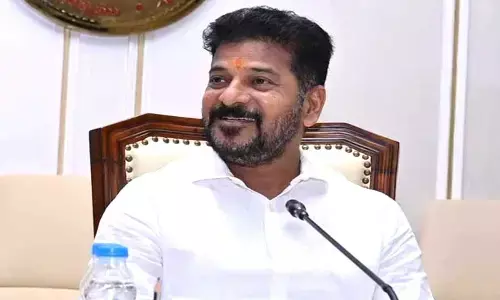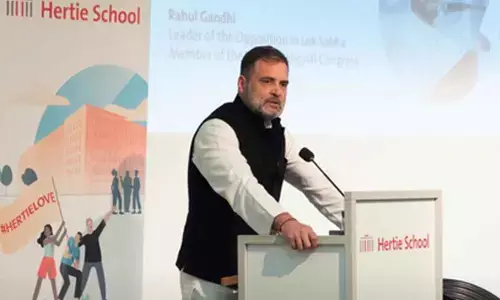Teachers need to prod students to question

Teachers Need To Prod Students To Question, Chukka Ramaiah, President Pranab Mukherjee. Recently, President Pranab Mukherjee said at Viswa Bharathi that ‘perpetual creation should be the motive force for all educational institutions’.
Recently, President Pranab Mukherjee said at Viswa Bharathi that ‘perpetual creation should be the motive force for all educational institutions’. Stating that knowledge is “constant, expansive and infinite”, he said that it can neither be confined within the four walls nor set in one pattern or one structure.
I felt thrilled to read these views, for last week I, too, had an opportunity to share similar ideas for a beautiful vision, with stalwarts united in their ideology that innovations in education would be the corner stone to our bright future, when a one-day seminar was organised by the Jubilee Hills Educational Society, involving more than 400 students and faculty from 25 government schools sharing the platform with students from the ‘high-end’ public schools of the city.
If innovation is the key, and if education is the golden gateway, let us see what the major factors are contributing to innovation here. Changes in teachers’ attitude towards the process of education, their perspective on student-centric methods, the optimum utilisation of available infrastructure and resources, adaptability to the fast-changing socio-cultural scenario and demands are some areas. Are we utilising our capabilities fully/are we geared for the forthcoming IT expansion on a large scale/are we aware of the pitfalls on our way?
.jpg)
Complacence is a dangerous thing while ignorance is inexcusable and boastful talk is self-destructive for any individual or nation alike. We need not see beyond our neighboring countries, both big and small to come out of our casual, lethargic and overconfident attitude in repeating the age-old saying “India is great; we are the best in the world intellectually…” Of course, even today, 25 per cent of all successful innovations in the USA are by our Indian students and it assures us that we have the capability, then while China has trains which can run at a speed of 350-500 km per hour and while it is undertaking a railway line connecting Beijing with London, why don’t we have any such achievements and though we too have sufficient iron and cement stocks, why is our national infrastructure building many times less than that of China? A small country like Korea has captured the world’s electronic trade, and a very small country like Singapore, which is dependent on others even for its food and water resources, has its GDP equal to that of the US, all because of its successful education programme! Can we now be still complacent?
Education in the past century was for knowledge acquisition mainly while for the future it has to be a skill acquisition to transform raw material into consumer goods or to generate quality human capital, it is to bring out the ‘thinking’ man who can be an asset to his nation instead of a liability. For this change in education, the key players are the teachers and teachers all along.
They need to evolve constantly, update themselves almost hour to hour, and be ready for the changes in the classroom scenario without clinging on to the methods they were taught in. The teachers’ monopoly in talking has to be given up, the idea that a silent class is a disciplined and successful class has to be banned, the misconception that questioning in a class is a mark of audacity, the opinion that students who talk and discuss with their classmates while working out a problem are distracting the class and similar ideas have to be replaced now with new ways where a class can be noisy in a productive way, where they feel free to question, share their answers with their peers and see the different ways in which a problem can be analysed etc.
Unless the curiosity, ability to question and to think differently are encouraged from the primary level, how can we expect quality research after post-graduation? While international Olympiads are now giving importance to individual performance as well as team performance, if we do not allow our youngsters to share and see a ‘win-win’ scenario, how can they progress? The teacher needs to provoke thinking instead of providing solutions to the students .The teacher must understand that all children are actually thinking and ready to speak if the teacher is ready to listen in the right way. Gaining their trust through listening is the first step in the new chapter of education.
To enable a teacher bring these changes, we need innovations in our methodology too. Value-based, technical education has to take the lead and we can encourage a research and development wing in every school, promote the ‘small wins’ theory in thinking so that students realise the true meaning of ‘thinking’ ‘research’ etc. as things which we normally do many times, on many occasions but have become ‘stiff-necked and tightlipped’ when any one asks us to do it on purpose with a focus to solve a problem or look at things in a different way.
If the students start thinking differently, they can have many feasible solutions for day-to-day problems in an innovative, simple, cost-effective way. More than necessity being the mother of inventions, it is like empathy is the source of these youngsters’ inventions, be it in designing a sustainable device to reduce the risks of pole climbing, using a four wheeler smoothly on the available infrastructure ,devising a ‘desi’ clay-molded fridge or many more.
In this context, however much we talk of the tremendous work being done by ‘Agastya’ is too little. Twelve years after it started, Agastya now functions in 12 States across India. Its target group is government-school children from Stds. V to X. Around 500 children visit the labs on their campus every day.
Specialised science labs, along with labs in mathematics, arts, ecology, a planetarium and discovery centre, stocked with models (like Whispering dish, Hyperbolic slot, and Momentum machine) that are typically seen in the best science museums around the world are within the reach of students from government schools where even the minimum infrastructure is rare.
One of the resource team’s breakthroughs is the ‘lab in a box’. A full set consists of 10 briefcases with around 15 to 20
experiments in each, it covers all subjects. The models are miniature versions and the teams identify village schools, and circulate the boxes among them. This has resulted not only in a breakthrough in understanding the sciences, but also an improvement in academic performance, and hopefully a higher chance of opting for science courses in college. Over the four or five years of their visits, many below average students became proficient in science. Such innovations can never be copied enough.
By innovative approaches, let us not confine ourselves once again to any one method like e-learning, blackboards, digi-content, labs alone etc. Any method that may be unconventional but good enough to yield positive results need not be swept aside. The recent venture by the Social Welfare department in guiding more than 20 youngsters in the age group of below 17 to scale the Himalayas is appreciable.
All the participants were unanimous in voicing their utmost gratitude for the opportunity given, the thrill in travelling and seeing the Himalayas, enjoying the benefits of team work, physical exercise and discipline which instilled greater confidence in them. Child prodigies and special kids or challenged kids are like two ends of the same thread and each should be given the necessary space, scope for growth and realisation in this ‘inclusive education’ we aim at. If utilising the services of local volunteers helps the slow learners, let us promote it.
If there are special ways of spotting and promoting special talents, not just because their parents were smart enough to identify the prodigies, let us not leave such avenues untapped, for I believe that our nation has even today, many unidentified Gems. Let us think constantly of reinforcing our educational mega-structure with all possible innovations which enhance the scope of all the learners’ holistic development, higher order thinking, social skills as well as interpersonal skills.
Next Story




















